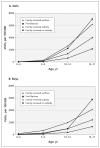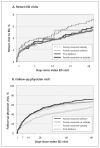Emergency health care use and follow-up among sociodemographic groups of children who visit emergency departments for mental health crises
- PMID: 22690003
- PMCID: PMC3447077
- DOI: 10.1503/cmaj.111697
Emergency health care use and follow-up among sociodemographic groups of children who visit emergency departments for mental health crises
Abstract
Background: Previous studies of differences in mental health care associated with children's sociodemographic status have focused on access to community care. We examined differences associated with visits to the emergency department.
Methods: We conducted a 6-year population-based cohort analysis using administrative databases of visits (n = 30,656) by children aged less than 18 years (n = 20,956) in Alberta. We measured differences in the number of visits by socioeconomic and First Nations status using directly standardized rates. We examined time to return to the emergency department using a Cox regression model, and we evaluated time to follow-up with a physician by physician type using a competing risks model.
Results: First Nations children aged 15-17 years had the highest rate of visits for girls (7047 per 100,000 children) and boys (5787 per 100,000 children); children in the same age group from families not receiving government subsidy had the lowest rates (girls: 2155 per 100,000 children; boys: 1323 per 100,000 children). First Nations children (hazard ratio [HR] 1.64; 95% confidence interval [CI] 1.30-2.05), and children from families receiving government subsidies (HR 1.60, 95% CI 1.30-1.98) had a higher risk of return to an emergency department for mental health care than other children. The longest median time to follow-up with a physician was among First Nations children (79 d; 95% CI 60-91 d); this status predicted longer time to a psychiatrist (HR 0.47, 95% CI 0.32-0.70). Age, sex, diagnosis and clinical acuity also explained post-crisis use of health care.
Interpretation: More visits to the emergency department for mental health crises were made by First Nations children and children from families receiving a subsidy. Sociodemographics predicted risk of return to the emergency department and follow-up care with a physician.
Figures



Similar articles
-
Emergency Department Use and Postvisit Care for Anxiety and Stress Disorders Among Children: A Population-Based Cohort Study in Alberta, Canada.Pediatr Emerg Care. 2016 Oct;32(10):658-663. doi: 10.1097/PEC.0000000000000747. Pediatr Emerg Care. 2016. PMID: 26945191 Free PMC article.
-
Emergency Health Care Use among Sociodemographic Groups of Children Presenting to Emergency Departments for Self-Harm in Alberta.CJEM. 2015 Sep;17(5):497-506. doi: 10.1017/cem.2015.1. Epub 2015 Mar 30. CJEM. 2015. PMID: 25822045
-
Predicting time to emergency department return for anxiety disorders and acute stress reactions in children and adolescents: a cohort study.Soc Psychiatry Psychiatr Epidemiol. 2015 Aug;50(8):1199-206. doi: 10.1007/s00127-015-1073-7. Epub 2015 May 23. Soc Psychiatry Psychiatr Epidemiol. 2015. PMID: 26002412
-
Factors associated with repeat emergency department visits for mental health care in adolescents: A scoping review.Am J Emerg Med. 2024 Jul;81:23-34. doi: 10.1016/j.ajem.2024.04.018. Epub 2024 Apr 15. Am J Emerg Med. 2024. PMID: 38631148
-
Current Pediatric Emergency Department Innovative Programs to Improve the Care of Psychiatric Patients.Child Adolesc Psychiatr Clin N Am. 2018 Jul;27(3):441-454. doi: 10.1016/j.chc.2018.02.004. Epub 2018 Apr 17. Child Adolesc Psychiatr Clin N Am. 2018. PMID: 29933793 Review.
Cited by
-
How safe are paediatric emergency departments? A national prospective cohort study.BMJ Qual Saf. 2022 Oct 19;31(11):806-817. doi: 10.1136/bmjqs-2021-014608. BMJ Qual Saf. 2022. PMID: 35853646 Free PMC article.
-
Predicting time to emergency department re-visits and inpatient hospitalization among adolescents who visited an emergency department for psychotic symptoms: a retrospective cohort study.BMC Psychiatry. 2016 Nov 9;16(1):385. doi: 10.1186/s12888-016-1106-0. BMC Psychiatry. 2016. PMID: 27825324 Free PMC article.
-
An evaluation of satisfaction with emergency department care in children and adolescents with mental health concerns.CJEM. 2023 Jun;25(6):498-507. doi: 10.1007/s43678-023-00511-4. Epub 2023 May 3. CJEM. 2023. PMID: 37133634 Free PMC article.
-
Addressing paediatric mental health concerns.Paediatr Child Health. 2013 Jun;18(6):293-4. Paediatr Child Health. 2013. PMID: 24421694 Free PMC article. No abstract available.
-
Youth Mobile Response and Stabilization Services: Factors Associated with Multiple Episodes of Care.Community Ment Health J. 2023 Nov;59(8):1619-1630. doi: 10.1007/s10597-023-01153-7. Epub 2023 Jun 22. Community Ment Health J. 2023. PMID: 37347420
References
-
- Dolan MA, Mace SEAmerican Academy of Pediatrics, Committee on Pediatric Emergency Medicine, American College of Emergency Physicians and Pediatric Emergency Medicine Committee Pediatric mental health emergencies in the emergency medical services system. Pediatrics 2006;118:1764–7 - PubMed
-
- Dolan MA, Fein JACommittee on Pediatric Emergency Medicine Technical report: pediatric and adolescent mental health emergencies in the emergency medical services system. Pediatrics 2011;127:e1356–66 - PubMed
-
- Kataoka SH, Zhang L, Wells KB. Unmet need for mental health care among US children: variation by ethnicity and insurance status. Am J Psychiatry 2002;159:1548–55 - PubMed
-
- Sturm R, Ringel JS, Andreyeva T. Geographic disparities in children’s mental health care. Pediatrics 2003;112:e308. - PubMed
Publication types
MeSH terms
Grants and funding
LinkOut - more resources
Full Text Sources
Medical
